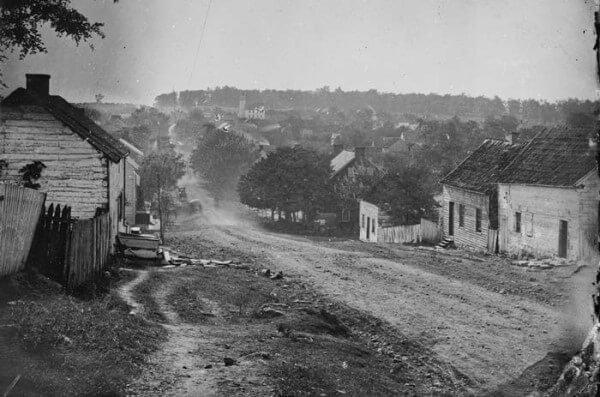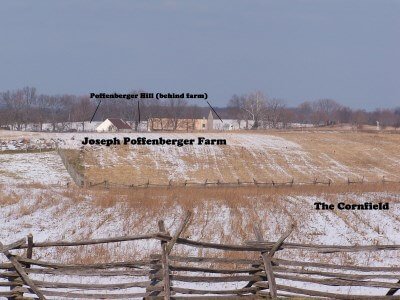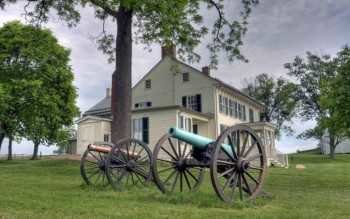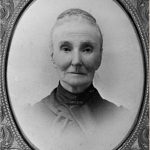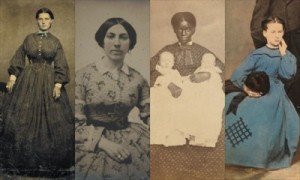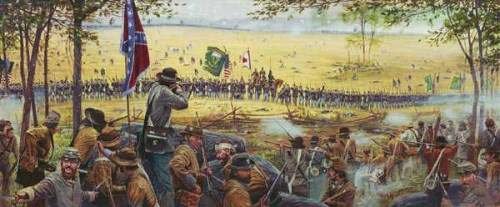Female Soldiers and Nurses at Antietam
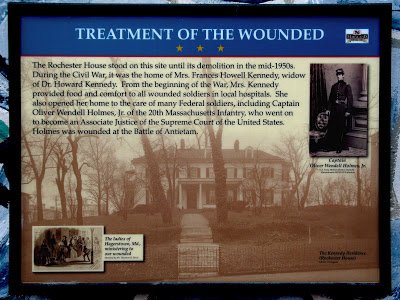 Fought on September 17, 1862, the Battle of Antietam was the first battle to occur on northern soil, and it is the bloodiest single-day battle in American history, with a combined tally of dead, wounded and missing at 22,717. Also known as the Battle of Sharpsburg, it took place near Sharpsburg, Maryland and Antietam Creek.
Fought on September 17, 1862, the Battle of Antietam was the first battle to occur on northern soil, and it is the bloodiest single-day battle in American history, with a combined tally of dead, wounded and missing at 22,717. Also known as the Battle of Sharpsburg, it took place near Sharpsburg, Maryland and Antietam Creek.
Image: Rochester House Marker
Where Oliver Wendell Holmes Jr. was treated for his wounds
The battle occurred after 75,000 Union troops under General George B. McClellan followed the 38,000 Confederate troops led by General Robert E. Lee into Maryland. On the morning of September 17, McClellan launched attacks against Lee’s left flank near Antietam Creek. The Confederates counterattacked and the battle spilled onto Miller’s cornfield near Dunker Church and into the East Woods, West Woods and the Sunken Road.
By the afternoon, Union troops captured a stone bridge over Antietam Creek and charged the Confederate’s right flank. Confederate reinforcements, fresh from the Battle of Harper’s Ferry, arrived just in time to counterattack and drove back the Union soldiers, ending the battle. The wounded were carried to one of the 70 field hospitals established in barns and churches near the battlefield.
By the end of the twelve hour battle, 2,108 Union soldiers and 1,546 Confederate soldiers lay dead; most of them were buried in shallow graves on the battlefield. According to the book Battle of Antietam: The Bloodiest Day, soil erosion and digging by wild hogs exposed many of the remains in the years after the war. Antietam National Cemetery was established for Union soldiers in 1867. Confederate remains were relocated to the Washington Confederate Cemetery in Hagerstown in 1870.
The battle successfully thwarted General Lee’s attempts to push farther north and was considered a strategic win for the Union. The success of the Union Army at Antietam encouraged President Abraham Lincoln to issue the Emancipation Proclamation, which freed slaves in Union-occupied areas of seceded states and and laid the groundwork for the passage of the 13th amendment.
Female Soldiers at Antietam
Eight soldiers who fought there were women disguised as men; seven were Union soldiers, and one was a Confederate. Most of the female Union soldiers have been identified: Sarah Emma Edmonds of the 2nd Michigan Infantry, Catherine Davidson of the 28th Ohio Infantry, Rebecca Peterman of the 7th Wisconsin Infantry, Ida Remington and Mary Galloway. The Confederate woman was killed, and her identity remains a mystery.
Sarah Emma Edmonds dressed like a man and served as soldier Frank Thompson at the Battle of Antietam. In her book Nurse and Spy in the Union Army (1865), she described the Maryland Campaign:
The brilliant and triumphant victories at South Mountain and Antietam, which more than counterbalanced the disastrous campaign of [General John] Pope, and which sent a thrill of joy throughout the North.
Catherine Davidson received a serious wound when she was shot in the right arm, and was reportedly carried to an ambulance by Pennsylvania Governor Andrew Gregg Curtin. Thinking she was dying, she gave Curtin her ring to thank him for carrying her. Davidson survived but her arm had to be amputated halfway between the shoulder and elbow:
Later, Davidson met Governor Curtin while dressed as a woman and told the surprised governor who she was. Curtin had worn Davidson’s ring since that day at Antietam. When he offered to return it to her, Davidson refused, saying, “The finger that used to wear that ring will never wear it again. The hand is dead but the soldier lives on.
Rebecca Peterman and Ida Remington fought in the early and deadly phase of the battle commonly referred to as The Cornfield, and escaped unharmed. Rebecca Peterman had enlisted in the 7th Wisconsin Infantry in the fall of 1862, at the age of sixteen. She was known to be an adventurous country girl from Ellenboro, Wisconsin, and war sounded exciting to her. Even after her brother died in late 1862, she stayed in the ranks for another two years.
Mary Galloway
A Frederick, Maryland woman by the name of Mary Galloway had just joined the Army of the Potomac days earlier, hoping to find her beau, Lieutenant Harry Barnard of the Third Wisconsin. She was shot in the neck at Antietam and lay wounded in a ravine for nearly thirty-six hours before she was discovered and carried to a field hospital. According to the book Woman of Valor: Clara Barton and the Civil War, Galloway refused treatment from male doctors.
Clara Barton treated Galloway’s wounds, and soon discovered that she was a woman. With Barton’s help, Galloway then allowed the male surgeon to remove the bullet that had entered her neck and embedded itself under the skin of her shoulder. She made a full recovery and returned to Frederick, where she waited for news of her beloved.
When a soldier being treated for a wound suffered at Antietam spoke of his sweetheart named Mary, an effort was made to locate the girl. Meanwhile Barton was searching as well, and helped Galloway find her soldier in a Washington hospital, and the couple were reunited. Mary married her soldier boy, and they named their daughter Clara.
Clara Barton at Antietam
In the middle of September 1862, volunteer nurse Clara Barton hurried to the area of Antietam Creek near Sharpsburg, Maryland where a major battle was imminent, but was stuck behind the Union army’s neverending line of supply wagons. Every time her drivers tried to move her wagon ahead of the others, they were pushed into the ditch.
She decided to wait until the Union wagons stopped for the night, and then she prodded her drivers to keep the the mules going all night to get closer to the front of the line. Barton finally arrived at the battlefield on the night of September 16 to find the armies poised for battle. “It was a miserable night. There was a sense of impending doom,” Barton wrote.
Once the battle began the following morning, nurse Barton searched for a place to help and found a farm northeast of the main battlefield where 300 wounded men were being treated. Arriving at the northern edge of the infamous Cornfield on the David Miller farm at about noon, she found surgeons trying to dress wounds with cornhusks.
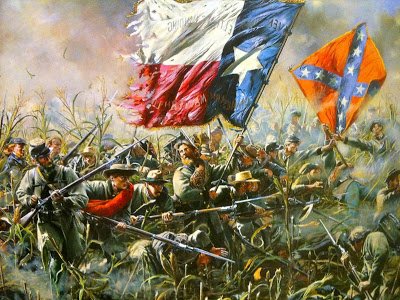 Image: Lone Star 1st Texas
Image: Lone Star 1st Texas
In the Cornfield at Antietam
By Don Troiani
Army medical supplies were far behind the fast-moving army, but Barton brought with her a wagon load of bandages and other medical supplies that she had personally collected over the past year. And the surgeons were soon back in the business of treating wounds. Soon after her arrival, she removed a bullet from a soldier’s cheek with a pocket knife when it was clear he would have to wait for hours for a surgeon.
In her bonnet, red bow and dark skirt, Clara Barton went to work. As bullets whizzed overhead and artillery boomed in the distance, she prepared food for the soldiers in a nearby farmhouse, and brought water to the wounded men. As she knelt to give a wounded man a drink, she was almost killed. She described the experience in a letter to a friend:
A man lying upon the ground asked for drink – I stooped to give it, and having raised him with my right hand, was holding the cup to his lips with my left, when I felt a sudden twitch of the loose sleeve of my dress – the poor fellow sprang from my hands and fell back quivering in the agonies of death – a ball had passed between my body and the right arm which supported him – cutting through the sleeve, and passing through his chest from shoulder to shoulder. There was no more to be done for him… I have never mended that hole in my sleeve. I wonder if a soldier ever does mend a bullet hole in his coat?
Working non-stop until dark, she comforted the men and assisted the surgeons with their work. As they began to run out of food, Barton’s assistants unpacked crates of wine as a last effort to tide the soldiers over and discovered that the last three crates were packed in cornmeal rather than sawdust. She immediately began turning it into gruel to feed more men.
The battle ended in the late afternoon of September 17; both armies were too damaged to continue. As the sun began to go down, the surgeons stopped their work for lack of light, Barton brought out some lanterns from her wagon of supplies, and the doctors continued with their work.
Within a few days after the battle, the Confederates retreated and the wagons of Union medical supplies began rolling into Sharpsburg. Barton continued to work for days until she collapsed from lack of sleep and the early stages of typhoid fever. She was transported to a Washington, DC hospital lying in a wagon, exhausted and delirious, but she was back with the army by mid-October.
Eventually, many of the small hospitals were consolidated into larger facilities. Once a soldier was healthy enough, he could be sent to more permanent hospitals in Frederick, or to Camp Curtain in Harrisburg, Pennsylvania. Soldiers too injured to travel remained in Sharpsburg area hospitals until spring 1863. Hundreds of displaced civilians eagerly welcomed the hospital consolidation.
Frances Howell Kennedy
On the corner of Prospect and Washington streets in Hagerstown, Maryland once sat a large house that was called the Rochester House, which was the home of Frances Howell Kennedy, widow of a Hagerstown physician. On September 20, 1862, she saw a young soldier at the train station, who had a bandage around his throat and was walking very languidly. Kennedy asked him to come to her home until he was able to travel, and he accepted the invitation.
Fortunately for our country, Oliver Wendell Holmes Jr. would live to serve on the U.S. Supreme Court from 1902 to 1932. A Civil War Trails marker stands where the Rochester House once stood and tells of its connection to Holmes:
The Rochester House stood on this site until its demolition in the mid-1950s. During the Civil War, it was the home of Frances Howell Kennedy, widow of Dr. Howard Kennedy. From the beginning of the War, Mrs. Kennedy provided food and comfort to all wounded soldiers in local hospitals. She also opened her home to the care of many Federal soldiers, including Captain Oliver Wendell Holmes Jr. of the 20th Massachusetts Infantry, who went on to become an Associate Justice of the Supreme Court of the United States. Holmes was wounded at the Battle of Antietam.
In an address delivered on Memorial Day, May 30, 1884, Oliver Wendell Holmes Jr. said of his wartime experience:
…the generation that carried on the war has been set apart by its experience. Through our great good fortune, in our youth our hearts were touched with fire. It was given to us to learn at the outset that life is a profound and passionate thing. …we have seen with our own eyes… the snowy heights of honor, and it is for us to bear the report to those who come after us…
Such hearts – ah me, how many! – were stilled twenty years ago; and to us who remain behind is left this day of memories… Year after year lovers wandering under the apple trees and through the clover and deep grass are surprised with sudden tears as they see black veiled figures stealing through the morning to a soldier’s grave…
But grief is not the end of all. I seem to hear the funeral march become a paean. I see beyond the forest the moving banners of a hidden column. Our dead brothers still live for us, and bid us think of life, not death – of life to which in their youth they lent the passion and joy of the spring…
The bloody stalemate at Antietam was a Union victory only in the sense that McClellan retained command of the field and Lee’s first northern invasion had ended without accomplishing anything other than drawing attention away from the farms of the Shenandoah Valley. Both army commanders deluded themselves. McClellan wrote to his wife, “They tell me I fought the battle splendidly.” Lee thought he had won a victory until reports came in about the rate of desertions in his army.
SOURCES
Clara Barton at Antietam
Civil War Saga: Battle of Antietam
Mass150: Clara Barton at the Battle of Antietam
Civil War Saga: Female Soldiers at the Battle of Antietam
Battle of Antietam: Union Surgeons and Civilian Volunteers Help the Wounded
